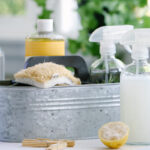Switching to Non toxic cleaning products doesn’t have to be overwhelming, expensive, or complicated. If you’re just getting started, know this: even small, intentional changes can make a huge impact on your health, home, and the environment. With rising concerns over chemical exposure in conventional cleaners, more people are choosing safer, greener alternatives. Non Toxic Cleaning Products breaks it down—what to swap, why it matters, and how to do it without fuss.
Why Go Non-Toxic?
Most conventional cleaning products are filled with synthetic fragrances, harsh solvents, and preservatives that can cause respiratory issues, skin irritation, and long-term health concerns. Even “fresh-scented” sprays and disinfectants can release volatile organic compounds (VOCs) into the air, polluting your indoor environment more than outdoor city smog.
On the other hand, Non toxic cleaning products are made with natural, biodegradable ingredients like vinegar, baking soda, essential oils, and plant-based surfactants. They are safer for kids, pets, and people with allergies—and better for the planet.
Start Small: Simple Swaps for Everyday Cleaning
You don’t need to overhaul your entire cleaning cabinet overnight. Start with the basics. Here are five beginner-friendly swaps that actually work.
1. All-Purpose Cleaner: Vinegar + Water
Instead of chemical-laden multi-surface sprays, mix equal parts distilled white vinegar and water in a spray bottle. Add 10–15 drops of essential oil (like lemon or tea tree) for a pleasant scent and added antibacterial power.
Use it for: Countertops, glass, stainless steel, tile, and even microwave interiors.
Tip: Don’t use vinegar on natural stone like granite or marble—it can etch the surface.
2. Glass Cleaner: Rubbing Alcohol + Cornstarch
Ditch the blue glass cleaner that leaves a chemical trail. Combine 1 cup water, 1 cup rubbing alcohol, and 1 tablespoon cornstarch. Shake well before each use. This formula gives you streak-free mirrors and windows every time.
Use it for: Glass, chrome, and shiny surfaces.
3. Floor Cleaner: Castile Soap + Warm Water
Conventional floor cleaners often leave behind a sticky residue and strong odor. Instead, use 2 tablespoons of liquid Castile soap in a bucket of warm water. It’s gentle, effective, and safe for most sealed floors.
Use it for: Tile, laminate, hardwood (sealed), and vinyl.
4. Toilet Bowl Cleaner: Baking Soda + Vinegar
To avoid bleach fumes, sprinkle baking soda into the toilet bowl and follow with a splash of vinegar. Let it fizz for a few minutes before scrubbing with a brush.
Use it for: Toilets, sinks, and drains.
5. Air Freshener: Essential Oil Spray
Synthetic air fresheners can trigger asthma and migraines. Instead, fill a spray bottle with water, 1 tablespoon of alcohol (vodka works!), and 10–15 drops of your favorite essential oil. Shake and spray.
Use it for: Bathrooms, bedrooms, closets, and pet areas.
Read the Labels (Even Natural Ones)
Just because a product is labeled “green” or “eco-friendly” doesn’t mean it’s truly non-toxic. Greenwashing is real. Brands often use vague terms that sound safe but aren’t regulated. To stay informed:
-
Look for third-party certifications like EWG Verified, USDA Organic, or EcoCert.
-
Avoid products with “fragrance” or “parfum” unless they disclose the source.
-
Research unknown ingredients using resources like the Environmental Working Group (EWG) database.
Top Store-Bought Non-Toxic Brands for Beginners
If DIY isn’t your thing, don’t worry. Plenty of reliable brands offer ready-made non-toxic options. Some beginner favorites include:
-
Seventh Generation – Known for transparent labeling and effective plant-based cleaners.
-
Branch Basics – A concentrate-based system that’s great for budget-friendly bulk cleaning.
-
Blueland – Offers refillable, tablet-based cleaners that are plastic-free.
-
Puracy – Made by chemists and tested by families, this brand is gentle and effective.
-
Dr. Bronner’s – Their Castile soap is incredibly versatile and can be used for dozens of cleaning tasks.
How to Build Your Beginner Non-Toxic Kit
Here’s a basic starter kit to cover most cleaning tasks:
| Product | Use | DIY Option |
|---|---|---|
| Distilled White Vinegar | Disinfectant, deodorizer | ✅ |
| Baking Soda | Scrubber, odor neutralizer | ✅ |
| Castile Soap | General cleaning | ✅ |
| Essential Oils (Tea Tree, Lemon) | Scent, antibacterial | ✅ |
| Spray Bottles (Glass or BPA-Free) | Storage | ✅ |
| Microfiber Cloths | Reusable wipes | ✅ |
| Rubbing Alcohol | Streak-free shine | ✅ |
Start with these staples and build as you go. You’ll be surprised how much you can clean with just a few ingredients.
Myths About Non-Toxic Cleaning
Let’s debunk a few common myths:
-
Myth 1: Non-toxic means less effective.
Not true. Natural ingredients like vinegar and baking soda are time-tested disinfectants and deodorizers. It’s all about knowing how to use them correctly. -
Myth 2: You need dozens of products.
Nope. Most homes can be cleaned with fewer than 10 ingredients, many of which you already have in your pantry. -
Myth 3: It’s expensive.
Actually, DIY non-toxic cleaners can save you money. A gallon of vinegar and a box of baking soda cost less than most single commercial cleaners.
Building a Healthier Home, One Swap at a Time
Transitioning to Non Toxic Cleaning Products isn’t about perfection—it’s about progress. Whether you make your own spray or buy from a trusted brand, each swap brings you closer to a healthier home. You’ll breathe easier, reduce your exposure to harmful chemicals, and create a safer environment for your loved ones. So, next time you run out of cleaner, think before you restock. Maybe it’s the perfect moment to make your first non-toxic switch. You don’t need a science degree or fancy tools—just a little curiosity and a commitment to doing better.

